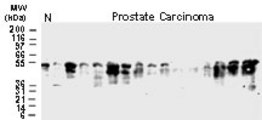
Formalin-fixed, paraffin-embedded tissue sections stained for BAR expression using LS-C148222 at 1:2000. A. Two cores from a human glioblastoma tissue microarray: 1 =fibrillary astrocytoma (grade I), and2 = anaplastic glioma (grade III). B. Higher magnification from the fibrillary astrocytoma (shown in A). C. Higher magnification from the anaplastic glioma (shown in A). D. Normal human brain striatum with positive medium spiny neurons, the major neuronal cell type of the striatum. Hematoxylin-Eos in counterstain.

Formalin-fixed, paraffin-embedded human prostate carcinoma tissue array stained for BAR expression using LS-C148222 at 1:2000. Hematoxylin-Eosin counterstain. Variable BAR expression is seen between patient samples.

Western blot of BAR in normal prostate and prostate carcinoma tissue lysates. 25 ug protein was loaded per lane. Tissue lysates from 15 different prostate carcinoma patients show variable expression of BAR with respect to banding patterns and amount of BAR expression. Major BAR bands typically migrate as a single band or as a doublet. These bands are typically observed at ~50-54 kD. This is higher than the predicted molecular weight from the 450 amino acid BAR sequence, and may represent phosphorylation or other post-translational modifications. N = tissue lysate from normal prostate.


